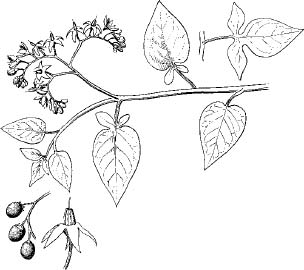Below is the content from page 264 (2nd ed.) 266 (1st ed.) and illustrations from 265 (2nd ed.) 267 (1st ed.) of Wild Plants of Greater Seattle.
|
Bittersweet (Nightshade)
Solanum Dulcamara
|
One of the Seattle
area's dozen worst weeds -- it is becoming more and more common. Though
this semiwoody vine is rarely more than
1⁄2" thick, it is capable of clambering 30'
or higher into trees. Introduced from Eurasia,
bittersweet is now abundantly naturalized here in many habitats, preferring moist places. Its bruised foliage
stinks like that of elderberry bushes. The leaves are 1-3" long and often bear
lobes near their bases. Bloom time begins mid- to late May. Flowers are
1⁄3 - 1⁄2" and purplish (occasionally white) with yellow centers -- the University of
Washington Husky colors. The flowers give rise to berries, gradually change from
green to yellow, next orange, and finally bright red. One very rare sport has berries
that stay orange even in decay, never developing the slightest red. When fully
ripe, the berries are harmless, not deadly. After autumn and frost yellows the
leaves, they drop, bidding good-bye to the colorful clusters of egg-shaped,
translucent, juicy berries hanging on the bare, withered stems.
|
Dogs can be poisoned if they eat this stinking, noxious pest. It is not all
bad: In herbal medicine, one use of the plant is for eczema. Some other names are: woody
or climbing nightshade, tether devil, felonwood,
felonwort, blue bindweed, poison flower, snake's poison
food, scarlet berry, and snakeberry. Note the omission of
"deadly nightshade," despite the fact that
a large number of people so call this plant. It also is not related to
enchanter's nightshade (Circæa alpina), a native woodland perennial sometimes weedy
in suburban gardens.
|

drawing by Jeanne R. Janish
|
Deadly Nightshade
Atropa
Bella-donna
|
The name nightshade is fascinating, evoking dread from most people, who hear scary things about it. In
Greek mythology, Atropos was one of the three fates -- "the blind Fury with the
abhorred shears," who cut the thread of life. The Language of Flowers assigns five meanings to
nightshade: (1) falsehood, (2) dark thoughts, (3) sorcery, (4)
witchcraft, and (5) scepticism. Consider the words of Gerard, originally penned
almost 400 years ago: "Nightshade causeth sleep, troubleth the mind, bringeth
madnesse if a few of the berries be inwardly taken, but if moe be given they also kill
and bring present death. If you will follow my counsell, deale not with the same
in any case, and banish it from your gardens, and the use of it also, being a plant
so furious and deadly."
|
Atropa Bella-donna, a European perennial, is happily exceedingly rare in
the Seattle area. The University of Washington Medicinal Herb Garden has grown
it for decades, and the only wild specimens noted in Seattle are within 3⁄4 miles away -- presumably spread
via birds. It truly lives up to the other ominous
names: death's herb, dwale, belladonna, raging
nightshade, naughty man's cherries, and dog
berries. It grows 3-5' tall, with leaves 3-8" long. The
bell-shaped flowers are greenish or dull brownish-purple, and
1 to 1 1⁄4" long. They are
solitary or paired in the leaf axils, from May onward. Shiny black berries,
1⁄2-3⁄4" long, follow.
|
The truth is: Some of the other
nightshades are good. You can fearfully avoid all, or learn who's who. Of our local
nightshades, the deadly species is literally outnumbered a million to one.
Back |

drawing by Jeanne R. Janish |

